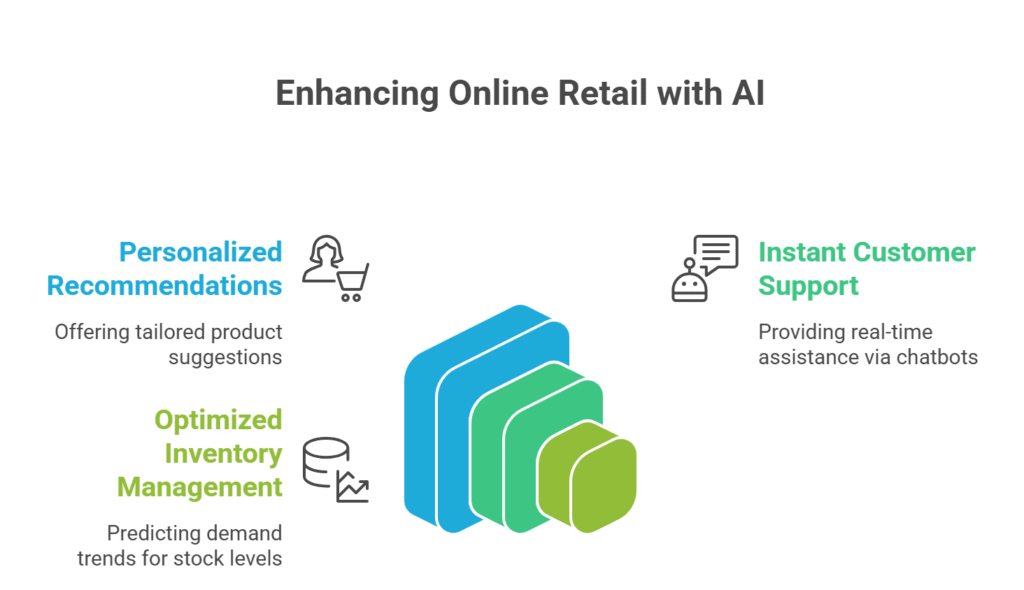
How artificial intelligence helps online stores?
Artificial intelligence (AI) has officially moved from the pages of science fiction to the heart of your online shopping cart. For e-commerce businesses, AI is no longer a futuristic buzzword but a foundational technology that is fundamentally reshaping how online stores operate, engage with customers, and drive profits. From personalized recommendations that feel like mind-reading to behind-the-scenes logistics that get your package to your door faster, AI is the silent partner powering the most successful online retailers.
If you run an online store or are simply curious about the invisible forces shaping your digital shopping habits, this deep dive is for you. We’ll explore the strategic applications of AI across e-commerce, break down the quantifiable return on investment (ROI), and look ahead to the future frontiers of AI-powered retail. Let’s unplug the hype and see how AI is delivering real-world results.

Supercharging the Customer Experience with AI 🛍️
In the crowded digital marketplace, the customer experience is the ultimate differentiator. AI is being deployed on the front lines to create shopping journeys that are more intuitive, engaging, and deeply personal. These aren’t just novelties; they are becoming the expected standard, directly impacting customer loyalty and sales.
Hyper-Personalization: The Art of the 1:1 Journey
The most profound impact of AI is the shift from broad marketing segments (like “millennial shoppers”) to true one-to-one hyper-personalization. By analyzing vast datasets—including your past purchases, Browse habits, location, and even real-time behaviour on a site—AI engines can predict what you want to see next.
- Product Recommendation Engines: This is the most famous application. When a store suggests products you’re genuinely interested in, it’s not a lucky guess; it’s a sophisticated algorithm at work. The financial impact is massive. Amazon’s recommendation engine, a pioneer in this space, is estimated to drive a staggering 35% of its total revenue. Retailers who implement advanced personalization report seeing a 40% increase in average order value (AOV) because they are successfully up-selling and cross-selling relevant items.
- Dynamic Content: Personalization goes beyond product carousels. AI can customize the entire digital storefront for each visitor. A returning customer might be greeted with a homepage featuring their favorite brands, while a new visitor sees best-selling or trending items. More than 70% of consumers now expect personalized experiences, making this a crucial capability for retaining customers.
Conversational Commerce: Your 24/7 AI Sales Assistant
Remember the clunky, frustrating chatbots of the past? They’ve evolved. Modern AI chatbots and virtual assistants, powered by Natural Language Processing (NLP) and generative AI, can understand complex queries, learn from interactions, and provide immediate, human-like assistance around the clock.
The impact is twofold. First, it boosts operational efficiency. AI chatbots can successfully handle up to 70% of customer conversations from start to finish, leading to operational cost savings of up to 47%. Second, they are powerful sales drivers. By engaging customers at critical moments, answering questions instantly, and offering tailored advice, these bots directly increase sales. During the 2024 Black Friday event, retailers using AI chatbots saw a 15% lift in conversion rates.
A great example is H&M’s chatbot, which acts as a virtual personal stylist, helping shoppers build entire outfits for specific occasions, bridging the gap between high-touch in-store service and online convenience.
Immersive Shopping: Trying Before You Buy with Augmented Reality (AR)
One of the biggest hurdles for online shopping has always been the inability to physically see or try a product. Augmented Reality (AR) is closing this gap. By overlaying a digital image onto the real world through your smartphone, AR lets you “try before you buy.”
- Virtual Try-On: Fashion and beauty brands allow you to virtually try on makeup, eyeglasses, or sneakers.
- Product Visualization: Furniture and home decor stores let you place a true-to-scale 3D model of a sofa in your living room to see how it fits and looks.
This technology dramatically increases purchase confidence. More importantly for businesses, it significantly lowers product return rates, a major cost center in e-commerce. It’s no surprise that 61% of consumers say they prefer to shop at stores that offer AR experiences. Google’s AI Try-On Tool and Sephora’s “Virtual Artist” are leading the charge, making online shopping more tangible and trustworthy.
Fortifying the E-commerce Backbone: AI in Operations ⚙️
While customer-facing AI gets the spotlight, its role in optimizing the critical, behind-the-scenes operations of an online store is just as transformative. AI is making e-commerce more efficient, resilient, and profitable.
Predictive Inventory and Demand Forecasting
Matching inventory with customer demand is a classic retail nightmare. Overstocking ties up capital, while understocking means lost sales and unhappy customers. AI-powered demand forecasting tackles this by analyzing historical sales data, market trends, seasonality, and even external factors like holidays or social media buzz to predict future demand with stunning accuracy.
The results are impressive. Retailers using AI for forecasting report a 20-50% reduction in forecasting errors. This translates directly to better inventory control, with businesses seeing up to a 30% reduction in stockouts and a 25% decrease in costly excess inventory.
Dynamic Pricing and Promotion Optimization
In the fast-paced digital world, static pricing is a recipe for leaving money on the table. AI-powered dynamic pricing engines allow retailers to adjust product prices in real-time based on a host of variables, including competitor pricing, customer demand, and inventory levels.
This allows retailers to maximize profit margins without sacrificing their competitive edge. For instance, an AI can detect when a competitor sells out of a popular item and automatically nudge the price up slightly. This level of responsiveness can lead to a direct margin improvement of 10-15%.
Automated Fraud Detection
The scale of e-commerce makes it a prime target for fraud. AI and machine learning are indispensable tools in this fight. These systems analyze millions of transactions to learn the patterns of legitimate customer behavior. When a new transaction occurs, the AI can instantly spot anomalies—like an unusually high-value order being shipped to a new address—and either block the fraudulent transaction or flag it for review. This automated, real-time defense is a core function for platforms like Shopify and Stripe, protecting billions of dollars in revenue for online merchants.
The Next Frontier: Generative AI, Ethics, and the Future of Shopping
The AI revolution is far from over. The advent of generative AI and a growing focus on ethical practices are paving the way for the next wave of innovation that will define the future of online retail.

Generative AI: Content and Marketing at Scale
For online stores with huge catalogs, creating unique and compelling product descriptions and marketing materials is a monumental task. Generative AI is a game-changer, automating content creation at an unprecedented scale.
- AI-Generated Product Descriptions: Tools like Shopify Magic can instantly write high-quality, SEO-friendly product descriptions from a few key details. This can reduce content creation time by as much as 80% and help stores avoid duplicate content penalties from search engines.
- AI-Driven Marketing: Instead of broad segments, AI can create thousands of hyper-targeted micro-segments based on real-time behavior. It then automates the creation of personalized emails and ad creatives for each segment, resulting in 37% higher engagement rates and a 29% lower customer acquisition cost.
Navigating the Headwinds: Privacy, Bias, and Cost
The path to AI adoption is not without its challenges. The investment can be significant, ranging from a few thousand dollars for off-the-shelf tools to millions for custom-built enterprise systems.
More importantly, there is a critical tension between personalization and privacy. Shoppers want tailored experiences, but 58% are worried about how AI uses their personal data. Navigating regulations like GDPR while building customer trust is paramount. Furthermore, the risk of algorithmic bias—where an AI learns and amplifies existing societal biases from its training data—is a major ethical concern. Brands must proactively work to ensure their AI systems are fair and transparent.
The Future of AI in E-commerce (2026 and Beyond)
Looking ahead, the evolution is accelerating.
- Agentic AI: The most disruptive shift will be the rise of autonomous AI shopping agents. These will be personal AI assistants that have a deep understanding of your preferences and are empowered to make purchases on your behalf, scanning multiple retailers to find the best product at the best price. The brand’s new “customer” will be another AI.
- Ethical AI as a Brand Differentiator: As consumers become more tech-savvy, a company’s commitment to responsible AI will become a key reason to earn their trust and loyalty. Transparency about data usage and fairness will be as important as product quality.
Conclusion
Artificial intelligence is no longer an optional add-on for online stores; it is the core engine of modern digital commerce. From crafting deeply personal customer journeys to optimizing complex supply chains, AI delivers a clear and quantifiable competitive advantage.
The businesses that will thrive in the coming decade will be those that embrace AI not just as a tool for efficiency, but as a strategic capability. They will master the technology, navigate its ethical complexities with integrity, and use it to build smarter, more responsive, and more trustworthy relationships with their customers. The AI revolution is here, and it is busy separating the retailers of the future from the relics of the past.

